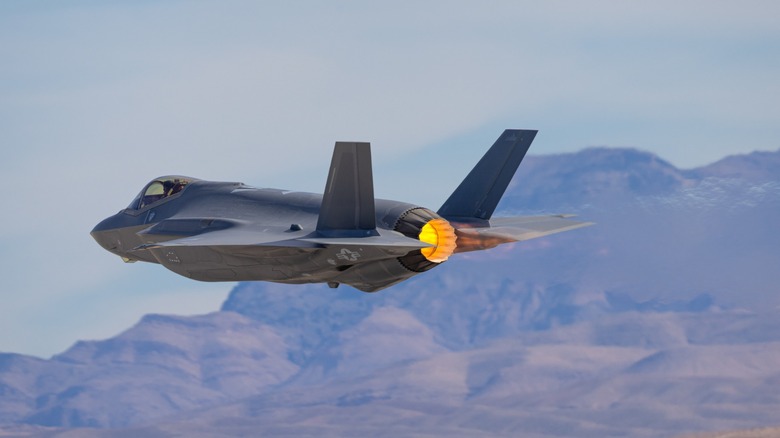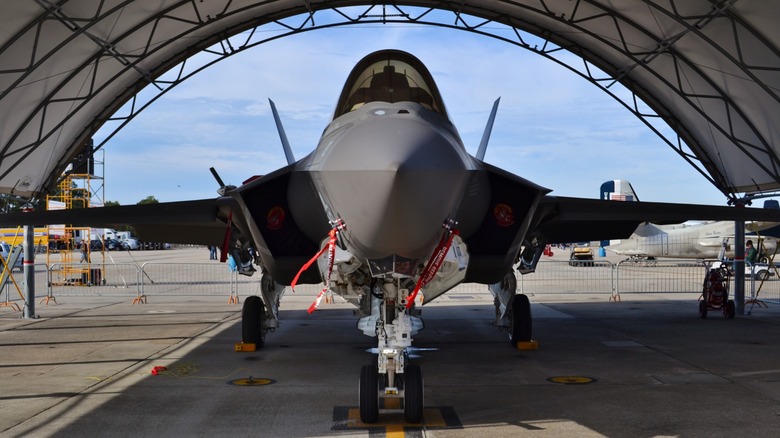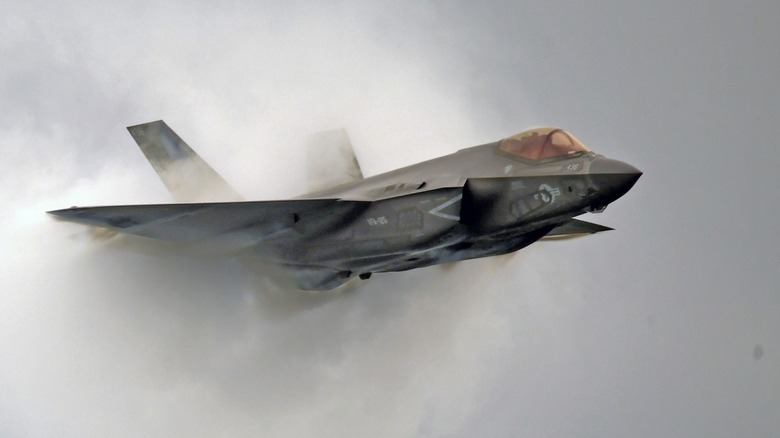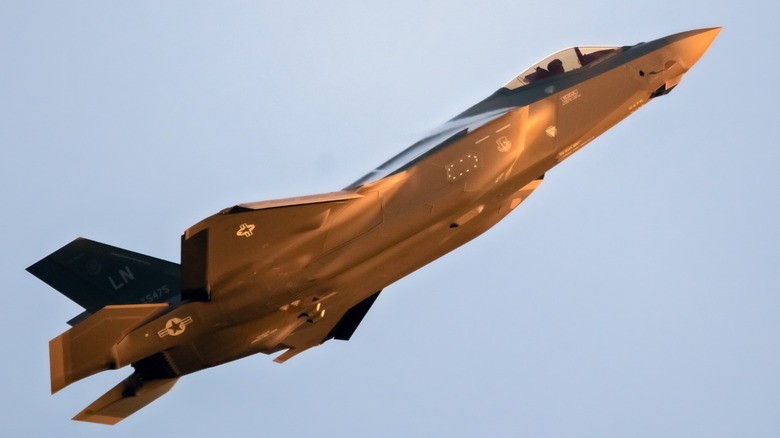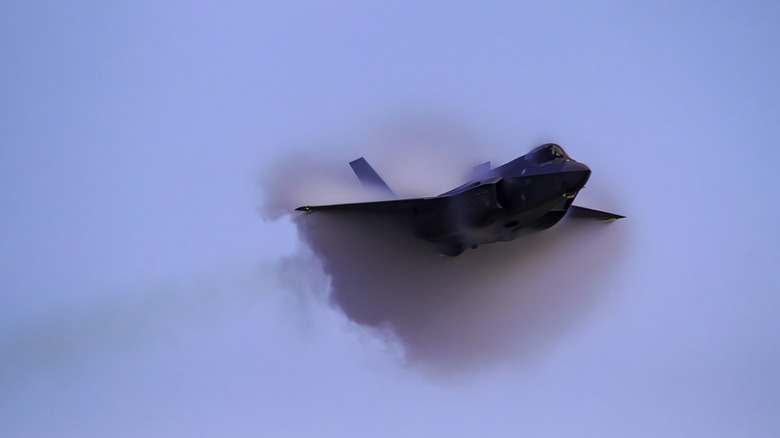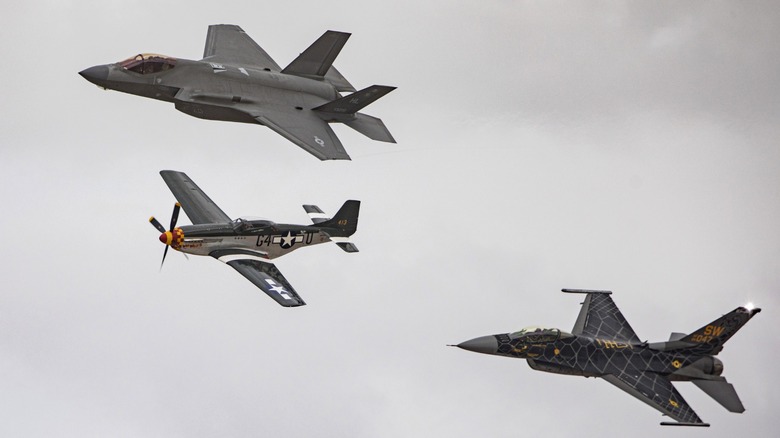Why America's F-35 Program Is So Controversial
While the F-35 Lightning II fighter jet is arguably one of the most advanced military jets in history, it also has many issues, making it a controversial topic in political circles. It was developed to replace the A-10 Thunderbolt II and F-16. Used by the U.S. Armed Forces, the F-35 is the biggest leap in aerial military tech since the late 1970s when the Thunderbolt II and F-16 were first designed and manufactured.
With development delays, ever-increasing costs, and ongoing issues with the plane that persist to this day, it's no wonder that many civilians and military leaders are displeased with the program's long production times and high costs. While in many ways, the development of the F-35 represents the power of U.S. military technology, in other ways, it's also a representation of beuracratic inefficiency and a stark example of potential overspending as a result of the global military-industrial complex.
What is the F-35 Lightning II?
The F-35 Lightning II is a fifth-generation military jet developed by Lockheed Martin and is arguably more advanced than any other military aircraft that came before it. A stealth jet undetectable by modern radar, the F-35 provides pilots and crew with comprehensive battlefield and maintenance data via various high-precision sensors found throughout the plane. Data is sent to a smart helmet called the Distributed Aperture System, which provides pilots with a 360-degree view and plane and combat data in the form of a heads-up display.
The stealth system, VL0, also makes the plane untargetable by enemy targeting systems, making the F-35 a dominant force in the skies. While data and stealth are the main reasons the F-35 Lightning II is a superior military aircraft, it also possesses frightening firepower. The F-35 Lightning II can carry four weapons internally and six additional weapons mounted on external hardpoints.
The standard payload for the plane includes two AIM-120C/D air-to-air missiles and two 1,000-pound GBU-32 JDAM air-to-ground guided bombs, along with an internal 4-barrel 25mm rotary cannon hidden to avoid radar. As impressive as the F-35's hardware sounds, it's also been at the center of controversy for its increasing cost and development times as well as issues with the plane itself.
The F-35 has been plagued with delays
One of the primary reasons that the F-35 is so controversial is the numerous delays and additional development time required to get the jet into combat shape. Compounding an extended development time is the mandatory customizations for each military branch. The F-35 first entered production in 2006, with the first planes set to be delivered by 2010. However, the project would fall at least seven years behind schedule.
In total, there are three variations of the F-35 for the U.S. Air Force, Marine Corps, and Navy, called the F-35A, F-35B, and F-35C. Each possesses different capabilities best suited for their branch of the military. While this development was required so that the F-35 could best fit with existing branch capabilities, it also increased the plane's development time.
The F-35 still has hardware issues and bugs, even though it's been in production for over a decade. These problems include things like stealth coating issues, problems with the helmet tech, and trouble with the weapons systems. The software required to run the plane's onboard systems consists of 24 million different lines of code with frequent bugs, sometimes forcing pilots to reboot the radar mid-flight to restart it. Perhaps most interesting was an issue that made the plane vulnerable to lightning. Regardless, these ongoing issues all add to the continued development time for the weapons system while simultaneously increasing their costs.
The F-35 is incredibly expensive
According to the U.S. Government Accountability Office, the F-35 aircraft program has exceeded its projected costs by $183 billion, with the Department of Defense estimating that the F-35 program will cost around $1.7 trillion over its 60-year lifetime. To put this into perspective, the National Defense Authorization Act, which is the budget for the U.S. military, allocated $816.7 billion in funding in 2023. This legislation funds the country's defense activities for all branches of the military, as well as new programs like increased housing money and special pay for service members.
Today, according to some estimates, the F-35A, the United States Airforce's version of the jet, costs $110.3 million per jet, a noticeable increase from Lockheed's previous $85 million estimate for the cost of the aircraft. The original plan of the DOD to purchase 2,852 planes worth an estimated $233 billion has since increased significantly, and this does not even include the $1.3 trillion in life cycle costs used to operate and maintain the F-35. Some argue that the immense cost to the American taxpayer doesn't outweigh the benefits of the more advanced technology onboard the craft.
There are ongoing problems with the F-35
Not all problems plaguing the development of the F-35 Lightning II are in the rearview mirror. According to reporting by The Hill, as recently as September of 2023, the military lost one F-35 over Charleston, S.C., after a pilot was forced to eject from the aircraft, requiring officials at Joint Base Charleston asking the public via social media whether anyone had found the plane.
And there have been a ton of other issues with the within the last few years. In 2022, 36 F-35s lacked the $12 million Lockheed engine and were grounded as a result. Politico reported in October of 2022 that production was temporarily halted when parts for F-35 production were found to be manufactured in China, creating a potential security risk that was later deemed to be nothing.
Finally, some military experts claim that the F-35 doesn't perform well in dogfights, with the older F-15 outpacing it in mock air battles. Others say that older bombers like the 1970s Thunderbolt are more effective at supporting ground troops and can fly further with larger payloads.
Countries are still buying F-35s
Most recently, Lockheed Martin was awarded a $7.6 billion dollar DoD contract for 129 additional F-35 fighters, which are expected to complete manufacturing in October of 2024. That being said, the future of the F-35 still remains unclear, with the U.S. military still relying on a mix of fighters that includes aircraft models one generation before the F-35.
According to Insider, on Oct. 8, 2023, the United States pledged F-35 and older fighter jets to the Middle East to discourage fighting beyond Israel's border as a response to the Israel conflict. These included F-35, F-15, F-16, and A-10 fighter aircraft squadrons, according to the reporting.
While it's still unknown exactly what will become of the F-35, Lockheed Martin has already sold the jet to 17 different countries, including the Czech Republic, Israel, and Greece, reducing the company's reliance on American defense funds. Only time will tell whether the F-35 Lightning II's reputation as history's most expensive lemon will prove true, as the combat jet has not yet proven itself to be as essential as the F-15 and other fourth-gen military fighter jets.
